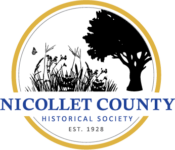Z Welcome New Neighbor
- October 2, 2021 - April 30, 2022
- Nicollet County Historical Society - Treaty Site History Center
- $6 adults
- $5 seniors ages 65+
- $4 children ages 5-17.
- NCHS members
- Children age 4 and younger
- Gustavus students, faculty, and staff with their campus ID.
Nicollet County Historical Society - Treaty Site History Center
The Treaty Site History Center is in St. Peter, MN, just off US Highway 169.
Address
1851 N. Minnesota Avenue
St. Peter, MN 56082
Accessible parking
A free parking lot is available at the site.
Two disability parking spots are located near the museum’s entrance.
The parking lot and sidewalk are paved.
General
Service animals are welcome
First aid kits are available.
Restrooms on-site are wheelchair accessible.
For visitors with mobility disabilities
The History Center is a single-floor venue.
Public restrooms in the History Center include accessible facilities and diaper-changing stations.
The Nicollet County Historical Society was organized on August 22, 1928. From its home in the Treaty Site History Center, the Nicollet County Historical Society preserves, protects, and interprets the history of Nicollet County and the state of Minnesota.
The Treaty Site History Center features a nationally recognized and award-winning exhibit on the Traverse des Sioux Treaty of 1851 and its consequences. Other features of interest include local history exhibits, a gift shop, and a full-service research archive.
Learn more